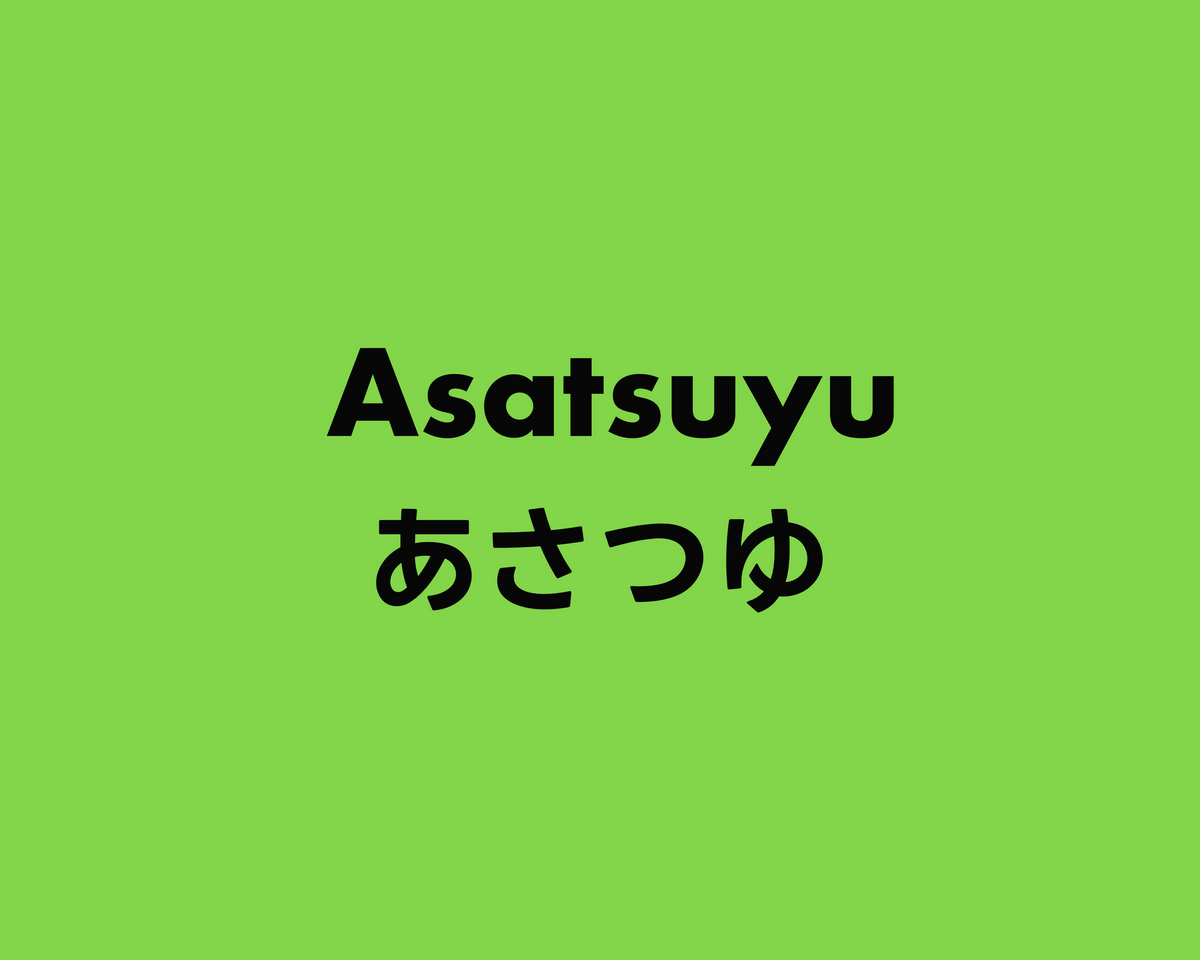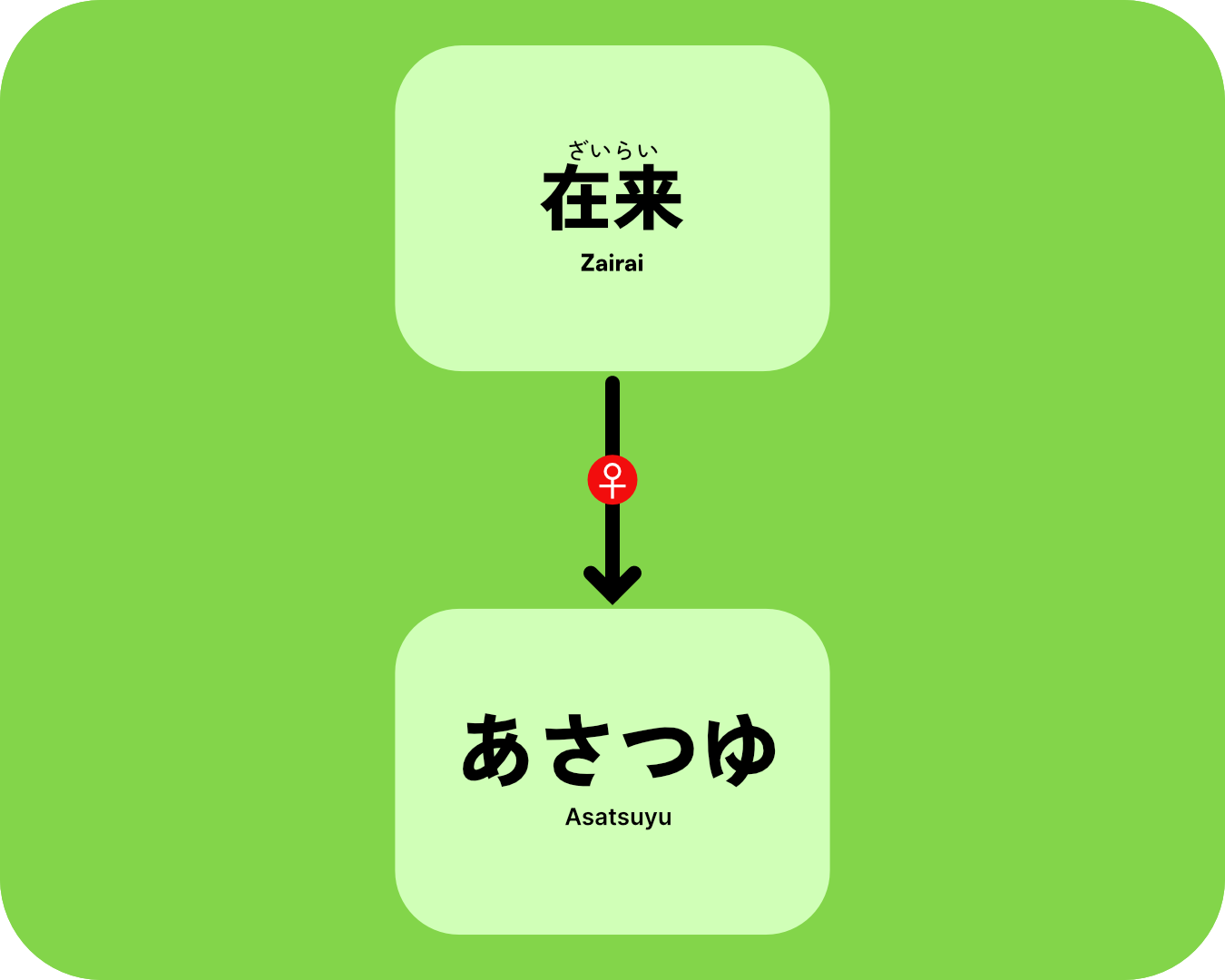Asatsuyu あさつゆ
Registered in 1953, selected from Uji landrace Zairai seedlings and known as natural gyokuro due to its bright-green color and sweet taste without the need for shading. This early-shooting cultivar is primarily grown in Kagoshima's warm climate...

Registered in 1953, selected from Uji landrace Zairai seedlings and known as natural gyokuro due to its bright-green color and sweet taste without the need for shading. This early-shooting cultivar is primarily grown in Kagoshima's warm climate and successfully crossbred into other important cultivars like Tsuyuhikari, Yutakamidori, and Saemidori.
Genealogy
Kyoto Uji landrace Zairai tea tree seed.

History
Asatsuyu became a registered cultivar in 1953, in the initial tea cultivar registrations under the Agriculture and Forestry Certified Cultivars[1], with registration No. 2. Registered after Benihomare and for use as a sencha cultivar.
The selection of this cultivar was from Uji landrace Zairai seedlings by the Agricultural Bureau Tea Experiment Station in Nishigahara, Tokyo, established in 1896 and part of the old Ministry of Agriculture and Commerce[2] that existed from 1881 until 1925.
In 1921, together with much other material, it was transferred to a different tea research facility established in 1919 that later became the modern Kanaya National Tea Research Institute in Shizuoka Prefecture[3]. The particular seedling that later became Asatsuyu started its testing trials in 1940 under the name U14[4].
In 1925, the Ministry of Agriculture and Commerce split into the Ministry of Commerce on one side. On the other side, the Ministry of Agriculture and Forestry[5] (1925–1978) was established, the predecessor of the current Ministry of Agriculture, Forestry, and Fisheries, MAFF for short.
After the establishment of MAFF, the registration of the cultivar falls under the Kanaya National Tea Research Institute in Shizuoka, part of the Institute of Fruit Tree and Tea Science. Which in turn belongs to the National Agriculture and Food Research Organization, NARO for short, under the umbrella of MAFF.
This cultivar is also known as natural gyokuro[6] due to its bright-green colour and sweet bean taste without the need for shading.
Characteristics
Compared to the Yabukita, it is an early shooting cultivar, with up to 6 days earlier harvest. Breeders noted its initial poor root development. As a curiosity, initial propagation used layering methods[7].
It is relatively resistant to cold but not to frost damage, especially as it is an early shooter, damaging the new buds leading to the first harvest. Recovery of the plant after frost damage is slow. Asatsuyu is a cultivar usually cultivated in more warm and temperate regions where the risk of frost is low, which in the case of this particular cultivar is Kagoshima.
As of 2012, it made up 1.2% of the total production in Japan, with around 500 ha cultivated. With 5% of total cultivation in Kagoshima but no significant amounts in other producing regions.
The average harvest quantity is lower than Yabukita, with smaller buds and more delicate leaves. Extra care in the post-harvest processing of the leaf material is needed. It also requires adequate field management to handle the plants' energy, as after the first harvest can decay considerably.
As its natural gyokuro nickname describes, it has some characteristics typically found in shaded teas like gyokuro or kabuse sencha. It showcases a bright, lush green colour in its leaves and liquor. Compared with Yabukita, it has a mellower aroma and a rich, balanced umami presence.
Asatsuyu has been crossbred successfully into other important cultivars like Tsuyuhikari, Yutakamidori, and Saemidori. As with Yabukita, it shares a weakness against anthracnose inherited by most of the descendants of these two cultivars. And in consequence, a common pest found in most tea gardens that use descendants of this cultivar, which are mostly suited for sencha.
7 out of 10 most common cultivars descend from Yabukita or Asatsuyu. This lack of genetic diversity presents a challenge, as the overall resistance to pests and disease remains low. That means that most of the cultivated tea is more vulnerable to these pests and diseases, further relying on the use of pesticides or other chemical products.
In Japanese 農林認定品種 ↩︎
In Japanese 農商務省. ↩︎
茶業研究所金谷 ↩︎
国茶U14号 ↩︎
農林省 ↩︎
In Japanese 天然玉露 ↩︎
Layering is a plant propagation method where a branch or stem is encouraged to develop roots while still attached to the parent plant. A portion of the stem is buried in soil, wounded, or treated to stimulate root growth. Once roots develop, the new plant is separated from the parent. ↩︎
References
Caicedo, Ricardo. “Asatsuyu.” My Japanese Green Tea, 10 Dec. 2013, https://www.myjapanesegreentea.com/the-asatsuyu-tea-cultivar.
Caicedo, Ricardo . “Japanese Tea Cultivar List.” My Japanese Green Tea, 8 Oct. 2013, https://www.myjapanesegreentea.com/japanese-tea-cultivar-list.
Florent. “The Japanese Tea Cultivars.” Japanese Tea Sommelier, 22 Aug. 2022, https://japaneseteasommelier.wordpress.com/2022/08/22/the-japanese-tea-cultivars/.
Florent -. “Senchas from ‘Nord-Kantô’, First Part: Sashima.” Japanese Tea Sommelier, 22 Oct. 2020, https://japaneseteasommelier.wordpress.com/2020/10/22/senchas-from-nord-kanto-first-part-sashima/.
Pandey, Abhay K., et al. “How the Global Tea Industry Copes With Fungal Diseases – Challenges and Opportunities.” Plant Disease, vol. 105, no. 7, July 2021, pp. 1868–79, https://doi.org/10.1094/pdis-09-20-1945-fe.
Wikipedia. “Layering.” Wikipedia, 13 Feb. 2023, https://en.wikipedia.org/wiki/Layering.
勝尾清. 最近の茶樹育種の発展と今後 (2) - Recent Development and Future of Tea Tree Breeding (2). 農業技術協會 - Agricultural Technology Association, Dec. 1971, p. 2, https://agriknowledge.affrc.go.jp/RN/2030041030.pdf.
農林水産省- Ministry of Agriculture, Forestry and Fisheries (MAFF). 新品種・新技術の開発・保護・普及の方針 茶 - Policy for Development, Protection and Dissemination of New Varieties and Technologies. https://www.maff.go.jp/j/kanbo/kihyo03/gityo/tuyomi/pdf/05-02tya.pdf.
農林水産省調 - Survey by the Ministry of Agriculture, Forestry and Fisheries. 茶園面積の品種別割合 - Percentage of Tea Plantation Area by Variety. 2012, https://www.google.com/url?client=internal-element-cse&cx=015840603635610229114:d5nyfxhiq78&q=https://www.maff.go.jp/j/wpaper/wmaff/h25/h25h/trend/part1/other/P135d2415.xls&sa=U&ved=2ahUKEwj0k7KY35X9AhUpBxAIHfjsBzsQFnoECAkQAg&usg=AOvVaw0RthQLQ0BxN0tuOdhXO5z. This one is a download of an excel file i found on the MAFF website, not accessible in any other way I could find.
農林省 - Ministry of Agriculture and Forestry. 茶の品種登録と命名 - Registration and Naming of Tea Varieties. Oct. 1953, p. 1, https://www.jstage.jst.go.jp/article/cha1953/1953/2/1953295/pdf/-char/en.
農林省茶業試験場. あさつゆ(品種解説シリーズ) - Asatsuyu (Explanation of Variety Series). 農林水産技術会議事務局 - Secretariat of Agriculture, Forestry and Fisheries Technology Council, Mar. 1968, p. 3, https://agriknowledge.affrc.go.jp/RN/2039015387.pdf.
農研機構 - NARO. “野菜茶業研究所:農業技術研修生 (茶業研修) 関係情報 - Vegetable and Tea Research Institute:Agricultural Technology Trainees (Tea Industry Training).” 農研機構 - Naro, https://www.naro.affrc.go.jp/archive/vegetea/introduction/kanaya/chagyokensyujoho/index.html#enkaku.
---. “野菜茶業研究所:農業技術研修生 (茶業研修) 関係情報 - Vegetable Tea Industry Research Institute: Agricultural Technology Trainee (Tea Industry Training) Related Information.” 農研機構 - Naro, 農研機構 - NARO, Aug. 2007, pp. 1–3, https://www.naro.affrc.go.jp/archive/vegetea/introduction/kanaya/chagyokensyujoho/index.html#enkaku.
静岡県茶業会議所. 茶の品種. 2003. 2nd ed., 静岡県茶業会議所, 2019, https://shizuoka-cha.com/index.php/books.
Last update: 2025 July 10th
